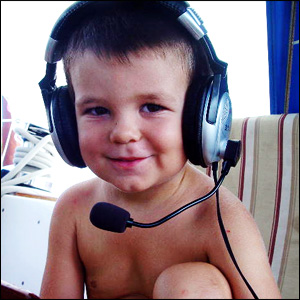8. How do you handle: EDUCATION and FULFILLMENT?
Schooling
We home school Marvin with the CNED (Centre National d’Education à Distance). It’s a French institution with a teacher assigned to us who follows the child.
How does that work?
After registering your child with this institution, you will receive books for the whole year: books for the teacher (you) and books for the child. The subjects are: French, math, science, geography, history, art, music and song plus a language of your choice when the child is 7 years old.
Our books are parents’ guides to help the child and give us some guidance in how to teach the material. Every 6 weeks, the child has to do evaluations, small exams (both written and oral recorded on cassette) and send them to the CNED. Teachers will correct and send the results back.
We found it easier to give them a fixed address. Otherwise, when a nice weather window appears, you can’t leave if you have to wait for those results. So my husband’s sister collects the results and scans and emails them to us.
The teacher will add comments for Marvin (to help him improve in a subject or with his writing) and also comments for us (to give us ideas how to tackle a subject). This program should take about 25 hours per week, depending on the child of course. We adapt the program when we are underway, focusing more on the oral, and we wait until we are at anchor or in port to do the writing part.
I have heard that other schools (in English) have approximately the same idea of schooling, but I have no info about those.
— Marvin (8): We have to do school only in the morning, not all day. That’s great! I have friends in Switzerland who go to school morning and afternoon... that’s too bad! I don’t really like school, so I try to do it quickly, and my afternoon is free. Then I can play with my friends, snorkel, do the wakeboard or sail my Optimist. (My parents gave me a course in Curaçao, and now, when the wind isn’t blowing too much, I sail my little boat around.)
Friendships and social interactions
We think it's important for a child to also have a social life, to compete and learn from others kids So we are careful about that, and every time we see a boat with kids on board we meet them whatever the nationality. They will do the same, so children pass easily from one boat to the other or play around together.
Sometimes we make them do school together also, so they can compete (even cheat) as they would do in school. Keeping the kids entertained
Books, toys, Gameboy, Nintendo DS, IPod, and more if you can, so kids can exchange, talk about it, share, etc.
If you stay long enough in one place, you will find activities for them: Optimist sailing, sailboard, courses they can take, or the chance to be a part of football or other training.
— Marvin (8): It’s great to play with others kids and learn new games.
I have a lot of toys on board, but it’s nice to build a cabane, play on the beach with hermit crabs, make a track and make them race from one point to the other, learn to play with nothing. Some children I met don’t have much to play with, so I gave them some of my toys, and they gave me some, like a seashell, or carved wood, a wooden boat, etc. I will keep them for sure. Every time I play with them I imagine my friends over there. Personal space aboard
Marvin doesn’t have his own cabin. He sleeps in the single berth in the passageway but has all of the forward area of the boat (double berth) to play.
We have an aft cabin, none of them are closed, the boat is open all the way through. There are no doors except for the head/toilet. Family back home and their concerns
 |
On Skype with Grandma |
That may be a worry. They miss us all, but especially their grandson.
Our decision to have this type of life is not easy for them.
- We try to fly home every year and a half, depending on the cost of the trip and if we can leave the boat safely somewhere. It all hinges on hurricane season, our work, and the price of a marina for New Life.
- Now these days, there is Internet, so we can keep in touch with them, and we can also phone with Skype and see each other via a webcam. Internet makes it easier, but of course it’s not the same as having us home or close by.
- When we leave for a long passage, we are not specific about when we are leaving, so they will not be worried. As soon we arrive somewhere, we phone them and talk about it.
- Family are always welcome to visit us, to stay in a hotel and come for a day sail with us. They are not sailors, so that is a good compromise. My mum comes sometimes and stays on board with us, and we do daysails with her also.
The best way to do it is when you are in the spot, contact your family and wait for them.
Otherwise, if you set a date in advance, you will be under pressure (dependent on the weather) to arrive in time to pick them up where they are meeting you. We experimented with a “rendezvous” at a set time of the year, but it’s always difficult because of our sailing schedule and the weather of course. If you give them in advance a destination and a time, for us to keep that date can be difficult. |
|